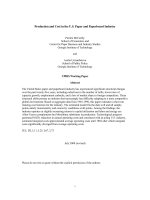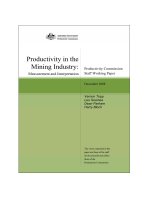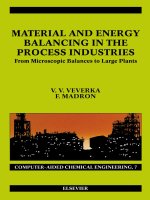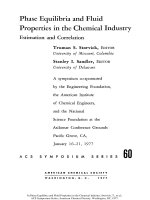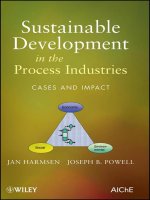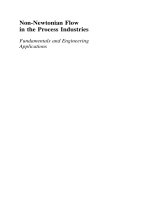sustainable development in the process industries cases and impact
Bạn đang xem bản rút gọn của tài liệu. Xem và tải ngay bản đầy đủ của tài liệu tại đây (1.78 MB, 289 trang )
Cases and Impact
Edited by
JAN HARMSEN
JOSEPH B. POWELL
SUSTAINABLE DEVELOPMENT
IN THE PROCESS INDUSTRIES
A JOHN WILEY & SONS, INC., PUBLICATION
SUSTAINABLE DEVELOPMENT
IN THE PROCESS INDUSTRIES
Cases and Impact
Edited by
JAN HARMSEN
JOSEPH B. POWELL
SUSTAINABLE DEVELOPMENT
IN THE PROCESS INDUSTRIES
A JOHN WILEY & SONS, INC., PUBLICATION
Copyright © 2010 by John Wiley & Sons, Inc. All rights reserved.
A Joint Publication of the Center for Chemical Process Safety of the American Institute
of Chemical Engineers and John Wiley & Sons, Inc.
Published by John Wiley & Sons, Inc., Hoboken, New Jersey.
Published simultaneously in Canada.
No part of this publication may be reproduced, stored in a retrieval system, or transmitted
in any form or by any means, electronic, mechanical, photocopying, recording, scanning, or
otherwise, except as permitted under Section 107 or 108 of the 1976 United States Copyright
Act, without either the prior written permission of the Publisher, or authorization through
payment of the appropriate per-copy fee to the Copyright Clearance Center, Inc.,
222 Rosewood Drive, Danvers, MA 01923, (978) 750-8400, fax (978) 750-4470, or on the web
at www.copyright.com. Requests to the Publisher for permission should be addressed to the
Permissions Department, John Wiley & Sons, Inc., 111 River Street, Hoboken, NJ 07030,
(201) 748-6011, fax (201) 748-6008, or online at />Limit of Liability/Disclaimer of Warranty: While the publisher and author have used their best
efforts in preparing this book, they make no representations or warranties with respect to the
accuracy or completeness of the contents of this book and specifi cally disclaim any implied
warranties of merchantability or fi tness for a particular purpose. No warranty may be created
or extended by sales representatives or written sales materials. The advice and strategies
contained herein may not be suitable for your situation. You should consult with a professional
where appropriate. Neither the publisher nor author shall be liable for any loss of profi t or any
other commercial damages, including but not limited to special, incidental, consequential, or
other damages.
For general information on our other products and services or for technical support, please
contact our Customer Care Department within the United States at (800) 762-2974, outside the
United States at (317) 572-3993 or fax (317) 572-4002.
Wiley also publishes its books in a variety of electronic formats. Some content that appears in
print may not be available in electronic formats. For more information about Wiley products,
visit our web site at www.wiley.com.
Library of Congress Cataloging-in-Publication Data:
Sustainable development in the process industries : cases and impact / edited by Jan Harmsen,
Joseph B. Powell.
p. cm.
Includes index.
ISBN 978-0-470-18779-1 (cloth)
1. Industrial ecology. 2. Sustainable development. I. Harmsen, Jan, 1950– II. Powell,
Joseph B., 1956–
TS161. S87 2010
670–dc22
2009033993
Printed in the United States of America
10 9 8 7 6 5 4 3 2 1
v
Contributors ix
Foreword xi
Preface xiii
1 Introduction 1
Jan Harmsen
1.1 Reason for This Book, 1
1.2 Scope of the Book, 2
1.3 Use in Education, 2
1.4 Use in Industry, 3
2 Sustainability Metrics, Indicators, and Indices for the
Process Industries 5
Joseph B. Powell
2.1 Overview and Scope, 5
2.2 Hierarchy of SD Metrics, Indices, and Indicators, 7
2.3 Practical Tools for the Process Industries, 10
2.4 Summary and Conclusions, 17
References, 19
3 Resource Effi ciency of Chemical Manufacturing Chains:
Present and Future 23
Jean-Paul Lange
3.1 Introduction, 23
3.2 Resource Effi ciency, 24
3.3 Economic Impact, 32
3.4 Conclusions, 35
References, 35
CONTENTS
4 Regional Integration of Processes, Agriculture, and Society 39
Michael Narodoslawsky
4.1 The Formative Character of Raw Materials, 39
4.2 The Systemic Engineering Challenge, 44
4.3 Regional Integration of Technologies, 46
References, 57
5 Eco-industrial Parks in The Netherlands: The Rotterdam
Harbor and Industry Complex 59
L. W. Baas and G. Korevaar
5.1 Introduction, 59
5.2 Industrial Ecosystem Programs in Rotterdam, 60
5.3 Conclusions, 76
References, 78
6 By-product Synergy Networks: Driving Innovation
Through Waste Reduction and Carbon Mitigation 81
Andrew Mangan and Elsa Olivetti
6.1 Introduction, 81
6.2 BPS Origins, 83
6.3 The BPS Process, 87
6.4 Barriers and Challenges, 94
6.5 Benefi ts and Opportunities, 97
6.6 Examples, 100
6.7 Conclusions, 106
References, 106
7 Fast Pyrolysis of Biomass For Energy and Chemicals:
Technologies at Various Scales 109
R. H. Venderbosch and W. Prins
7.1 Introduction, 109
7.2 Oil Properties, 114
7.3 Fast Pyrolysis Process Technologies, 120
7.4 Mass and Energy Balance for Production of Bio-oil
and Char in a 2-ton/h Wood Plant, 136
7.5 Bio-oil Fuel Applications, 139
7.6 Chemicals from Bio-oil, 144
7.7 Economics, 148
7.8 Concluding Remarks, 149
References, 150
vi CONTENTS
CONTENTS vii
8 Integrated Corn-Based Biorefi nery: A Study in Sustainable
Process Development 157
Carina Maria Alles and Robin Jenkins
8.1 Introduction, 157
8.2 Technology Development for an Integrated Corn-Based
Biorefi nery, 159
8.3 LCA Results: ICBR Versus Benchmarks, 165
8.4 Final Refl ections, 168
References, 169
9 Cellulosic Biofuels: A Sustainable Option for Transportation 171
Jean-Paul Lange, Iris Lewandowski, and Paul M. Ayoub
9.1 Introduction, 171
9.2 Case Studies, 175
9.3 Sustainability of Biomass Production, 183
9.4 Conclusions and Recommendations for R&D Activities, 194
Note Added in Proof, 196
References, 196
10 Integrated Urea–Melamine Process at DSM: Sustainable
Product Development 199
Tjien T. Tjioe and Johan T. Tinge
10.1 Short Summary of Melamine Development, 199
10.2 Current Uses of Melamine, 200
10.3 Urea Production, 201
10.4 Conventional DSM Stamicarbon Gas-Phase Melamine
Production Process, 202
10.5 New Integrated Urea–Melamine Process, 205
10.6 Conclusions, 207
References, 207
11 Sustainable Innovation in the Chemical Industry and Its
Commercial Impacts 209
Joseph B. Powell
11.1 Overview, 209
11.2 Historical Perspective, 210
11.3 Innovations in the Age of Sustainability, 212
11.4 Sustainability Driven by Innovation and Performance, 215
References, 216
viii CONTENTS
12 Implementation of Sustainable Strategies in Small and Medium-
Sized Enterprises Based on the Concept of Cleaner Production 219
Johannes Fresner and Jan Sage
12.1 Overview, 219
12.2 Active Strategies for Sustainable Management, 220
12.3 Eloxieranstalt A. Heuberger GmbH: Sustainable
Management in an Anodizing Plant, 221
12.4 Analysis of the Results, 226
12.5 Implementation of Sustainable Strategies, 230
Appendix: A Successful Regional Cleaner Production
Project, 231
References, 236
13 Sustainable Concepts in Metals Recycling and Mineral Processing 237
Nitosh Kumar Brahma
13.1 Overview, 237
13.2 Bioleaching Process Design and Development, 238
13.3 Bioleaching Reactor Design: Applicability of the Core
Particle Model, 241
13.4 Industrial Applications, 243
13.5 Conclusions, 245
References, 246
14 Industrial Ecosystem Principles in Industrial Symbiosis:
By-product Synergy 249
Qingzhong Wu
14.1 Introduction, 249
14.2 Relationship Between Industrial Symbiosis and Sustainable
Development, 250
14.3 Challenges, Barriers, and Countermeasures in Exploration,
Evaluation, and Implementation of Industrial Symbiosis, 252
14.4 What By-Product Synergy Is and Is Not, 253
14.5 Work Process and Successful Cases of Industrial Symbiosis, 254
14.6 Conclusions and Recommendations, 261
References, 263
Index 265
ix
Carina Maria Alles , DuPont Engineering and Research Technology,
Wilmington, Delaware
Paul M. Ayoub , Shell Technology Centre, Amsterdam, The Netherlands
L. W. Baas , Erasmus Centre for Sustainability and Management, Erasmus
University, Rotterdam, The Netherlands; Link ö ping University, Link ö ping,
Sweden
Nitosh Kumar Brahma , Indian Institute of Technology, Kharagpur,
W. Bengal, India; IGE - Badu - Kolkata, India
Johannes Fresner , STENUM GmbH, Graz, Austria
Jan Harmsen , State University Groningen, Groningen, The Netherlands
Robin Jenkins , DuPont Engineering and Research Technology, Wilmington,
Delaware
G. Korevaar , Delft University of Technology, Delft, The Netherlands;
Institute of Environmental Sciences, Leiden University, Leiden, The
Netherlands
Jean - Paul Lange , Shell Technology Centre, Amsterdam, The Netherlands
Iris Lewandowski , Shell Technology Centre, Amsterdam, The Netherlands
Andrew Mangan , U.S. Business Council for Sustainable Development,
Austin, Texas
Michael Narodoslawsky , Institute for Process Technology, Graz University
of Technology, Graz, Austria
Elsa Olivetti , Massachusetts Institute of Technology, Cambridge,
Massachusetts
CONTRIBUTORS
x CONTRIBUTORS
W. Prins , Biomass Technology Group, Enschede, The Netherlands; Ghent
University, Ghent, Belgium
Joseph B. Powell , Shell Global Solutions, Houston, Texas
Jan Sage , STENUM GmbH, Graz, Austria
Johan T. Tinge , DSM Research, Technology and Analysis Geleen, SRU
Industrial Chemicals, Geleen, The Netherlands
Tjien T. Tjioe , DSM Research, Technology and Analysis Geleen, SRU
Industrial Chemicals, Geleen, The Netherlands
R. H. Venderbosch , Biomass Technology Group, Enschede, The Netherlands
Qingzhong Wu , Environmental Technology Center, The Dow Chemical
Company, Plaquemine, Louisiana
xi
The book offers an important industry perspective on how companies develop
and design innovative solutions to complex environmental and societal chal-
lenges. It goes well beyond theory, offering case studies with quantifi able
results that illustrate how companies can save money while improving the
environment and helping local communities. It shows how small, medium -
sized, and large companies are using resources more effi ciently, sometimes by
teaming up with other industries, to achieve results that balance the triple
bottom line of people, planet, and prosperity.
This richly detailed study should be of great interest to industry leaders,
policymakers, scholars, and students of sustainable development.
Andrew Mangan
Executive Director
U.S. Business Council for Sustainable Development
FOREWORD
xiii
This book presents examples and approaches to the application of sustain-
ability in the process industries. Before describing some ways in which the
book can be used in courses and in industry, let ’ s look at the evolution of the
concept of sustainable development and how industry has played its role in
this evolution.
The term sustainable development was redefi ned and became globally
known through the publication of Our Common Future , commonly called the
“ Brundtland report ” (WCED 1987 ), which states:
Sustainable development is not a fi xed state of harmony, but a process of change
in which the exploitation of resources, the direction of investments, the orienta-
tion of technological development and institutional change are made consistent
with future as well as present needs. Sustainable development is development
that meets the needs of the present generation without compromising the ability
of future generations to meet their own needs.
It is clear from this description that sustainable development contains social,
cultural, environmental, and economic aspects and takes worldwide and long -
term perspectives into account.
After publication of the defi nition in 1987, the concept of sustainable devel-
opment was debated broadly and deeply by those in a variety of scientifi c and
academic fi elds (de Beer and Swanepoel 2000 ). It survived this discussion and
became broadly accepted by many governments. The fi nancial and business
world also adopted the concept, but defi ned it further by introducing three
essential dimensions of sustainable development: the social, ecological, and
economic dimensions (Serageldin 1993 ; Hart 1997 ; WBCSD 1997 ). Elkington
(1997) , in turn, transformed the concept into the triple bottom line of people,
planet, and profi ts. Soon after, a number of companies began to use it
(Shell 2000 ).
PREFACE
xiv PREFACE
According to the triple - bottom - line concept, in corporate activities equal
weight should be given to:
• People: the social consequences of its actions
• Planet: the ecological consequences of its actions
• Profi ts: the economic profi tability of companies (being the source of
“ prosperity ” )
The main point is that the “ bottom line ” of an organization is not only an
economic – fi nancial one — an organization is responsible for its social and eco-
logical environment as well. From this “ triple P ” perspective, an organization
that considers a strategy of sustainability must fi nd a balance between eco-
nomic goals and goals with regard to the social and ecological environment.
The adoption of triple - bottom - line concepts in industry helped to forward
its popularity by governments. In the United Nations World Conference on
Sustainable Development in Johannesburg, South Africa in 2002, the “ triple
P ” description was adopted and modifi ed, with profi t changed to prosperity .
To quote:
We, the representatives of the peoples of the world, assembled at the World
Summit on Sustainable Development in Johannesburg, South Africa, from 2 to
4 September 2002, reaffi rm our commitment to sustainable development. We
commit ourselves to act together, united by a common determination to save
our planet, promote human development and achieve universal prosperity and
peace (UN 2002 ).
— Johannesburg Declaration on Sustainable Development
Thus, industry helped make the concept of sustainable development more
applicable and, perhaps even more important, easier to remember, by intro-
ducing the terms triple P and triple bottom line . Moving beyond defi nitions to
actual implementation can be a challenge for any organization given the
expanded array of considerations required by the triple - bottom - line concept
and the frequent lack of quantitative metrics available for use in decision
making. Although some attention is paid to an overview of the current status
of metrics and methodologies in beginning chapters, the examples and case
studies that follow help us to focus on the more specifi c set of drivers that
affect decision making in applications across the process industries and related
disciplines. Topics include the design of industrial parks and synergistic indus-
trial networks, mining, chemicals, water treatment, and new domains, such as
biofuels, which are driven by a desire for more sustainable industries.
The book can be used in courses on sustainable development, regional
planning and development, industrial ecology, industrial metabolism, process
design, and innovation. It can, for example, be used in exercises to apply a
specifi c analysis or assessment method to a selected case study. It can also be
used to analyze and compare the approaches used to implement and apply
PREFACE xv
sustainability principles. Finally, it can be used in process design by giving it
as an exercise to improve a specifi c case process.
The book should also be useful in industry: by implementing approaches
described in the case - study processes, or by using the sustainable development
metrics and methods described. The cases come from small, medium - sized,
and large enterprises. The reader may notice interesting differences in the
methods used, depending on the size of the company or industrial branch.
Cross - fertilization may happen in this way.
ACKNOWLEDGMENTS
We thank the authors of and contributors to the chapters. Given the breadth
of the subject of sustainability, the variety of perspectives and insights pre-
sented by our fellow authors has made the preparation of this book an enrich-
ing exercise. We trust that you will fi nd it similarly insightful.
G. Jan Harmsen
Joseph B. Powell
REFERENCES
de Beer , F. , and H. Swanepoel . 2000 . Introduction to Development Studies . Oxford,
UK : Oxford University Press .
Elkington , J. 1997 . Cannibals with Forks . Oxford, UK : Capstone .
Hart , S. 1997 . Beyond greening: strategies for a sustainable world . Harvard Bus. Rev. ,
Jan. – Feb., pp. 66 – 76 .
Serageldin , A. 1993 . Making development sustainable . Finance Dev. , 30 ( 4 ): 6 – 10 .
Shell . 2000 . People, Planet & Profi t , The Shell Report 2000.
UN (United Nations) Department of Economic and Social Affairs, Division of
Sustainable Development) . 2002 . Johannesburg Declaration on Sustainable
Development, Sept. 2 – 4, 2002. Accessed Jan.2009 at />documents/WSSD_POI_PD/English/POI_PD.htm .
WBCSD (World Business Counsil for Sustainable Development) . 1997 . Exploring
Sustainable Development: Global Scenarios, 2000 – 2050 , London, UK .
WCED (World Commission on Environment and Development) . 1987 . Our Common
Future . Oxford, UK : Oxford University Press .
1
Sustainable Development in the Process Industries: Cases and Impact, Edited by Jan Harmsen
and Joseph B. Powell
Copyright © 2010 John Wiley & Sons, Inc.
1
INTRODUCTION
Jan Harmsen
State University Groningen, Groningen, The Netherlands
1.1 REASON FOR THIS BOOK
The editors of this book have long industrial experience in process develop-
ment and novel commercial - scale process implementations. In the past decade
we became convinced that sustainable development (SD) is a good driver for
innovation, as it makes good business sense to provide for the needs of people
in an ecological, economical, and socially acceptable way. Our company, Shell,
was adopted sustainable development as one of its business principles, as
have many other companies. Formation of the World Business Council for
Sustainable Development, with its large number of contributing companies
worldwide, is a good indicator of this new direction in global businesses.
However, we felt the lack of reported industrial cases necessary to convince
and inspire our colleagues, academics, and students that, indeed, sustainable
development has entered the process industry. We assumed that industrial
cases existed not only in our company but were also present in other compa-
nies. Evidence for this was obtained from the overwhelming response to a
proposed session of the American Institute of Chemical Engineers in the
spring of 2006 in Orlando, Florida, on “ Sustainability in Practice, ” which ulti-
mately swelled into a four - session topical conference. So when we asked our
peers in the process industry to provide written cases from their companies to
serve as chapters in this book, they responded quickly. All of them had to
Copyright © Shell Global Solutions International B.V. 2010.
2 INTRODUCTION
write the cases at least partially in their spare time, but they were suffi ciently
motivated to do so. Obtaining permission to publish the case descriptions
presented another hurdle, but that hurdle was also overcome. So what you
fi nd in this book are true industrial cases of novel processes or systems that
contribute to sustainable development based on the “ triple bottom line ” or
“ triple P ” dimensions of “ people, planet, and profi ts. ”
1
1.2 SCOPE OF THE BOOK
To make the book as useful as possible, we obtained cases from a variety of:
• Industries: oil and gas, bulk chemical, specialty chemical, material and
mineral processing
• Global regions: Asia, Europe, and the United States
• Systems: industrial ecopark, regional development, domestic - industrial
ecology, individual corporate operating sites
To the example cases we added methods and metrics that can be used by
industry to assess processes as to sustainability. All examples are real indus-
trial cases. Some of the processes are in the pilot - plant stage, but most have
already been implemented at a commercial - scale capacity.
1.3 USE IN EDUCATION
The book can be used in many different academic educational programs and
courses and in many different ways. Perhaps the fi rst use is to motivate stu-
dents to work on sustainable development, because it is a real business driver,
as shown in the industrial cases. In undergraduate courses, the book can be
used to provide students with real examples of industrial sustainable systems
and processes. Chapters 12 and 14 illustrate the concept of industrial ecology
with the closing of material cycles. A very simple and clear case on domestic
wastewater used as feed for boiler feedwater production is described in
Chapter 14 . A further example, on by - product synergy, is provided in Chapter
6 . Also, the translation of the high - level “ triple P ” dimensions into qualitative
and quantitative methods and metrics to assess real processes and their life
cycles are illustrated in the cases. In graduate - level courses, the book can be
used as test cases and scenarios for the evaluation of theories and frameworks
for sustainable development.
1
The origins of “ triple P ” (or “ 3P ” ), encompassing “ people, planet, and profi ts, ” and “ triple
bottom line, ” denoted as “ TBL ” or “ 3BL, ” are described in the preface and are attributed to
John Elkington in publications such as Cannibals with Forks: The Triple Bottom Line of 21st
Century Business (Oxford, UK: Capstone, 1997).
USE IN INDUSTRY 3
The benefi t of incorporating all three dimensions of sustainable develop-
ment (ecology, economy, and society) in solutions is highlighted by the exam-
ples provided in Chapters 3 to 6 . For industrial ecology courses, Chapters 4
to 6 and 14 will be useful. The cases presented can be used to illustrate the
practical use of the corresponding principles.
Courses on renewable energy can benefi t from Chapters 7 to 9 . Courses on
process design can benefi t from any of the industrial cases. In particular, the
closing of material cycles is illustrated in Chapter 12 , a case study from an
anodizing company.
Courses on life - cycle assessment can use Chapter 8 , based on an integrated
biorefi nery, and Chapter 14 , a case on industrial symbiosis in wastewater
management, where an end - of - cycle wastewater stream is upgraded to a feed-
stock for chemical processes. Cases throughout the book can be used to
analyze the various emission types and emission reductions obtained by the
synergy between a local society ’ s waste and the use of that waste by a company,
compared to the choice of a conventional solution.
1.4 USE IN INDUSTRY
The book can be used by anyone in industry to convince others in a company
that working on innovative processes and systems that contribute to sustain-
able development makes good business sense and to demonstrate that many
other companies are already doing it. An excellent treatment of value added
is presented in Chapter 6 using such an innovative process. The book can also
be used to apply sustainable development metrics to rank existing and novel
process alternatives for sustainability, and to give direction and guidance to
process innovation, and small and medium - sized enterprise companies can use
the very practical strategy provided to implement sustainable development in
their companies. In addition, the book can be used to obtain specifi c ideas and
insights on how to modify processes to direct them toward more sustainable
deployment of technology within an industry.
5
Sustainable Development in the Process Industries: Cases and Impact, Edited by Jan Harmsen
and Joseph B. Powell
Copyright © 2010 John Wiley & Sons, Inc.
2
SUSTAINABILITY METRICS,
INDICATORS, AND INDICES FOR
THE PROCESS INDUSTRIES
Joseph B. Powell
Shell Global Solutions, Houston, Texas
2.1 OVERVIEW AND SCOPE
This book is devoted to sustainability in practice , or how one translates the
often vague and high - level concepts of sustainability into action. It has been
said that a person can manage only that which can be measured and defi ned.
1
How then do we defi ne and measure sustainability? In the following review
we look at broad defi nitions and indicators of sustainability, followed by a
focus on a more specifi c subset of metrics and tools relevant to the process
industries.
The emergence of sustainability science and engineering as a meta -
discipline is described in a recent academic - center review (Mihelcic et al. 2003 );
a more in - depth review of sustainability metrics for the chemical and process
industries may be found in the book Transforming Sustainability Strategy into
Action (Beloff et al. 2005 ). Batterham (2006) presents a hierarchical perspec-
tive of sustainability for the practicing chemical engineer: from global objec-
tives, through enterprise and corporate strategies, to individual work tasks.
Practices and approaches recommended for use by the process industries are
1
“ Measure what is measurable, and make measurable what is not ” — quote attributed to Galileo
(Sikdar 2009 ).
Copyright © Shell Global Solutions International B.V. 2010.
6 SUSTAINABILITY METRICS, INDICATORS, AND INDICES
also available from chemical engineering institute working groups (AIChE
2000 ; ICheme 2002 ; Schuster 2007 ). A number of recent reviews of sustain-
ability metrics, indicators, and frameworks with assessment of state - of - the - art
implementation strategies have appeared from leaders in environmental agen-
cies, nonprofi t institutes, and universities. In this chapter we provide an over-
view of the current state of the art and best practices, with updates as to recent
trends and assessments. An extensive reference list is provided for use in the
implementation of sustainability frameworks and the use of metrics.
2.1.1 Defi nition of Sustainability
Although it is frequently stated that there is no agreed upon defi nition of
sustainability , the original defi nition of the United Nations ’ Brundtland
Commission (WCED 1987 ) is most often quoted and is widely accepted:
“ ‘ Sustainable ’ development is development that meets the needs of the
present without compromising the ability of future generations to meet their
own needs. ” This is quite a broad defi nition if one is looking for a directive
for tangible action.
Further clarifi cation is afforded by consideration of three impact areas
(Figure 2.1 ): (1), environmental, (2) economic, and (3) societal, or “ people,
planet, and profi ts, ” as part of the triple bottom line concept for corporate and
governmental responsibility (Elkington 1994, 1997 ). Sustainability is a consid-
eration of societal and environmental performance, on top of a broadened
concept of fi nancial performance that considers economic cost – benefi t impacts
beyond corporate profi ts. The need for sustainability results from the fact that
economic systems are imperfect and do not refl ect total costs or values, includ-
ing environmental and social impacts. Sustainability metrics thus attempt to
“ measure the immeasurable ” (Pint é r et al 2005 ; B ö hringer and Jochem 2007 )
Economic
Environ-
mental
Social
Sustainable
Development
Figure 2.1 Triple bottom line of sustainability, or “ triple P ” : people, planet, and
profi ts.


